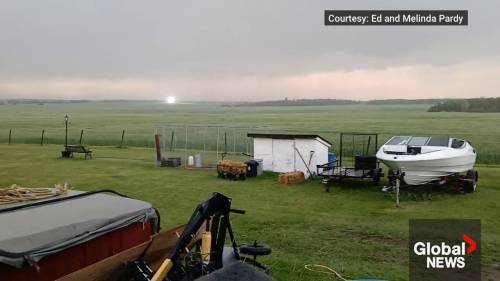I was sitting in my car just off Highway 2 when the Alberta skies turned an eerie shade of green-gray last Tuesday. The storm rolled in with surprising speed – something we’ve been seeing more frequently across the Prairies this spring.
But what Calgary resident Darryl Stein captured on his cellphone that afternoon wasn’t your typical Alberta thunderstorm. The video, which has since gone viral across Canadian weather networks, appears to show what meteorologists are calling a rare “heat burst” phenomenon – a dramatic temperature spike that occurred in mere minutes as warm air crashed to the ground.
“I’ve lived here my whole life and never seen anything like it,” Stein told me when I reached him by phone yesterday. “The temperature jumped about eight degrees in just minutes. You could actually feel the hot air rushing down.”
Environment Canada meteorologist Jesse Wagar confirmed the unusual nature of the event. “What we’re looking at is likely a heat burst, which occurs when a thunderstorm begins to collapse and sends a pocket of warm, dry air rapidly toward the ground,” Wagar explained.
The Alberta storm video captures the moment perfectly – dark clouds giving way to visible waves of air distortion, similar to what you might see above hot pavement on a summer day. These phenomena typically happen at night, making this daytime occurrence particularly unusual.
Dave Phillips, senior climatologist with Environment Canada, noted this is part of a growing pattern of extreme weather events across the Prairie provinces. “We’re seeing more intensity in our weather systems as climate patterns shift,” Phillips said. “The public documentation of these events helps us track these changes in real-time.”
The video has sparked considerable interest within both scientific and public communities. The Calgary Weather Network has reported three similar incidents across southern Alberta this spring, though none were documented as clearly as Stein’s footage.
Prairie storms have always had their distinctive characteristics, but longtime residents are noticing differences. Sandra Pollock, who has farmed outside Red Deer for nearly four decades, says the weather patterns feel less predictable. “My father taught me to read the skies, but lately they’re speaking a different language,” she told me when I visited the region last month for a story on changing agricultural practices.
Alberta’s position along the eastern slopes of the Rockies creates unique atmospheric conditions that can produce spectacular weather events. When cool mountain air collides with warm, moist air from the prairies, the results can be dramatic – and occasionally dangerous.
The provincial emergency management agency has seen a 23% increase in weather-related calls since 2019, according to their quarterly report released in March. This has prompted renewed calls for better early warning systems in rural communities.
“What’s particularly interesting about the heat burst phenomenon is how localized it can be,” says Dr. Michelle Cowan, atmospheric scientist at the University of Alberta. “You might experience it in one neighborhood while just kilometers away, conditions remain completely different.”
For weather enthusiasts, Alberta has become something of a hotspot for unusual atmospheric events. Social media groups dedicated to documenting Prairie storms have grown substantially, with the largest Facebook community now counting over 40,000 members who share photos and videos of everything from wall clouds to mammatus formations.
The growing public interest in weather phenomena reflects our changing relationship with climate. As weather patterns become less predictable, people are paying closer attention to the skies above them.
“Twenty years ago, most people wouldn’t know a heat burst from a cold front,” Phillips noted. “Now I get calls from regular folks who can describe complex meteorological events with impressive accuracy.”
For Stein, whose video continues to circulate online, the experience has turned him into an amateur weather watcher. “I’ve downloaded three weather apps since this happened,” he laughed. “My kids think I’ve gone weather-crazy, but when you see something like that firsthand, it sticks with you.”
Environment Canada encourages Albertans to report unusual weather events through their weather app or website. These citizen reports help fill observational gaps in their monitoring network, especially in rural areas where weather stations may be sparse.
As our climate continues to change, documenting these events becomes increasingly valuable to researchers trying to understand shifting patterns. What was once rare may become more common – or we may see new phenomena emerge that challenge our understanding of Prairie weather dynamics.
The Alberta storm video serves as a powerful reminder that even in our technologically advanced world, nature still has the capacity to surprise us. And sometimes, those surprises are captured perfectly on someone’s phone, giving us a glimpse into the fascinating complexity of the atmosphere above us.






